The Old Firm derby is always the biggest clash in Scottish football. In this midweek, Celtic took on Rangers at Celtic Park in a potential title decider as the race has been very tight in these months. Giovanni van Bronckhorst’s side only had a two-point lead before the match and a draw would secure their position at the top. The result might make the difference because Ange Postecoglou’s men looked like a group of hungry wolves who swallowed the opponents within 45 minutes.
This tactical analysis explains how Celtic won the match with the fluid positional tactics of Postecoglou and how they defended better than the opponents with a collective mindset in the pressing.
Lineups
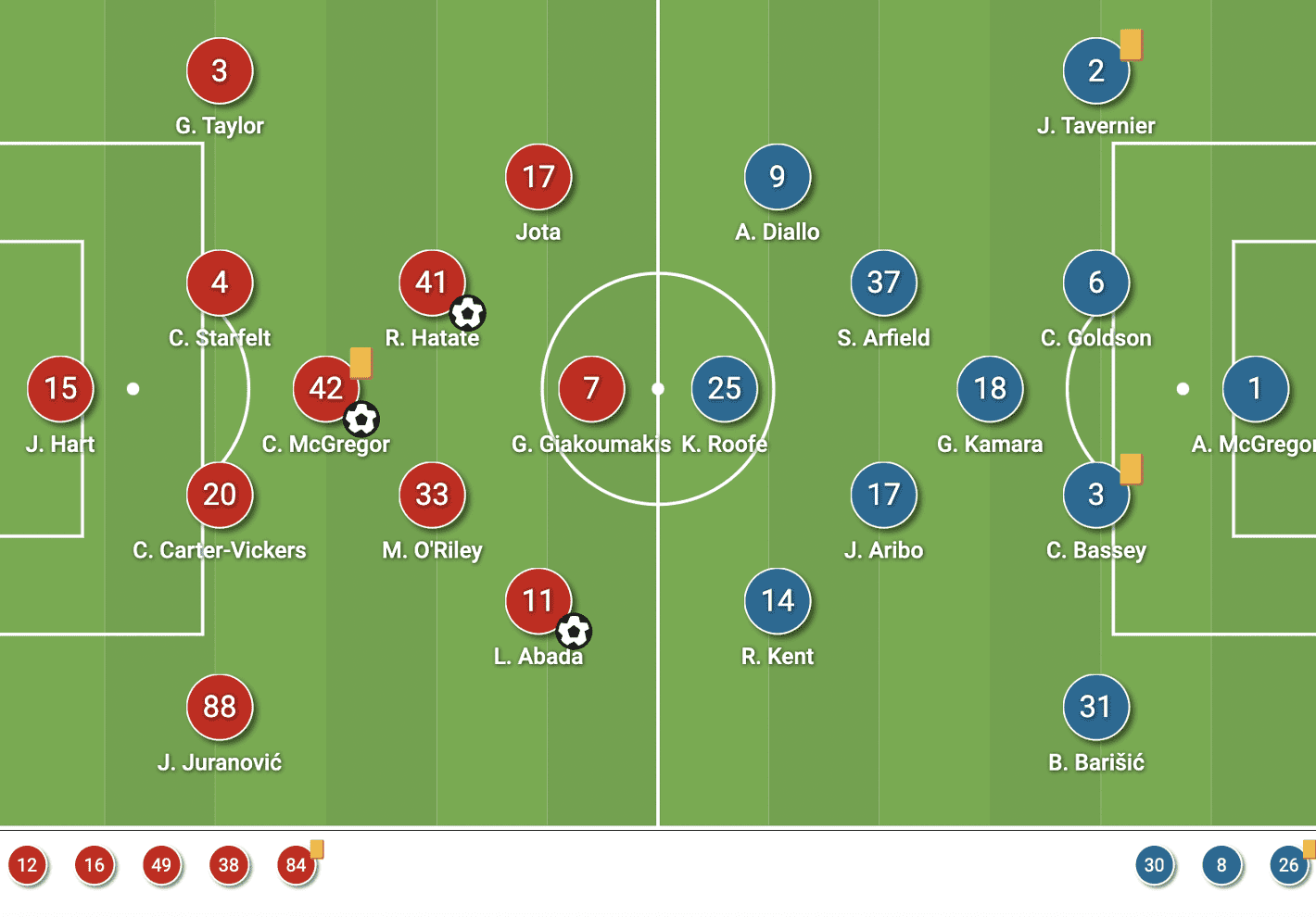
Celtic opted for a 4-3-3 formation as several players were out of the game, including the suspended Nir Bitton, unfit David Turnbull and Kyogo Furuhashi. But their young right-winger, Liel Abada improved greatly compared to September, he was a threat in this game; while Reo Hatate had a great first half and helped his team to kill the game.
Rangers also played in a 4-3-3 formation. The Manchester United loanee Amad Diallo quickly gained a position, starting as the right-winger but his performance was below par. The former academy player of Leicester City, Calvin Bassey, continued to start as a centre-back and paired up with Connor Goldson, but he played as the left-back since van Bronckhorst adjusted his tactics during the break.
Unstoppable Celtic rotations
Intriguingly, the 4-3-3 formations on paper were a bit inaccurate as both sides ended up in different shapes. The positional tactics of Celtic were fluid, rotations were involved in the attack, and we better apply the terms and concepts to explain rather than formations. No matter how, the key was to let the ball runs to the correct space and the structures were established to generate dynamics, passing lanes, resulting in final third entries and chances to score.
Rangers did not defend in a 4-3-3 either. Instead, the right attacking midfielder, Scott Arfield would push higher to join the striker, forming a 4-4-2 shape with Glen Kamara and Joe Aribo as 6s to cover. Their wingers were defending deep and inside, part of the reason was the inverted Celtic full-backs dragged them in. Their PPDA in the first half was 13.37 and that shows they were not intense in the pressing. Against Celtic’s 2-1 shape in the centre, Rangers let the centre-backs play and mainly blocked the centre by narrowing the passing lanes, expecting the opponents would play around the block.
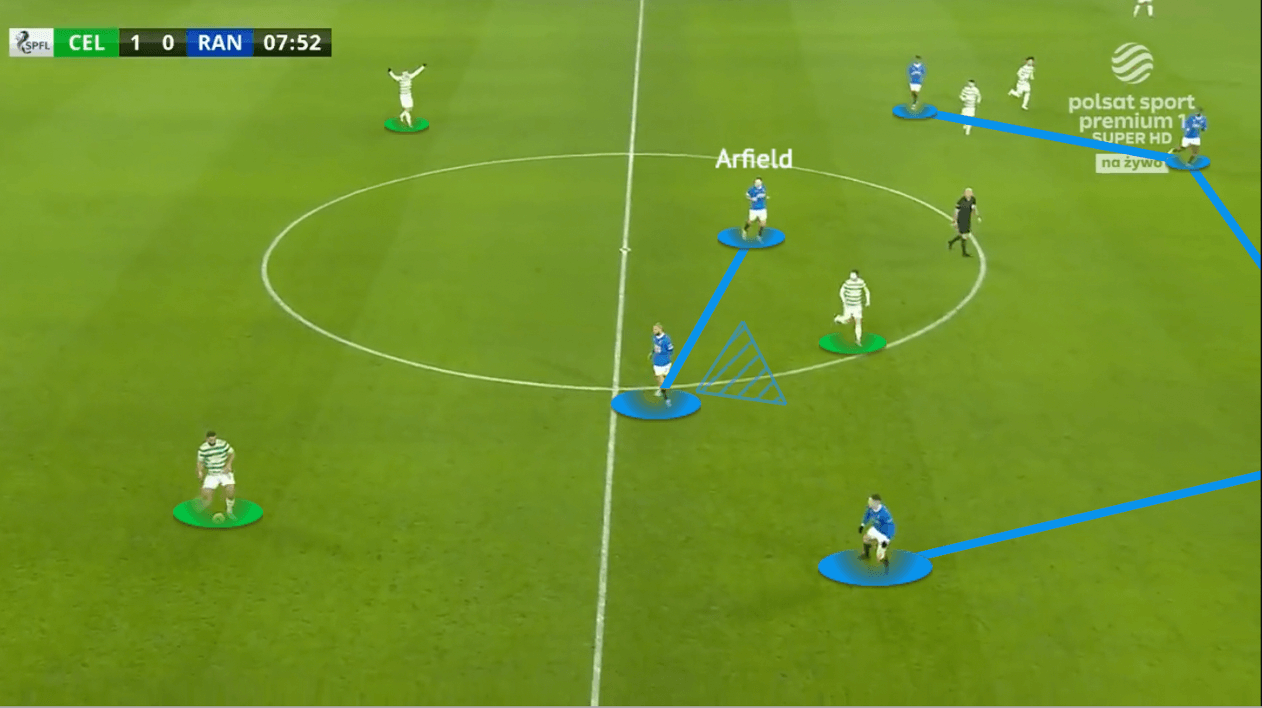
But this passive approach of Rangers also became an issue. Since van Bronckhorst’s side did not apply pressure to the ball, they were mostly reactive without possession and letting Celtic dictate the direction of the attack easily. Hence, most of the Celtic attacks in the first half were starting in the central third. Postecoglou’s side adopted a relatively conservative approach as they wished to obtain more control in this game.
Firstly, Celtic mostly attacked from the flanks with combinations by a full-back, a winger, and the 8. The left side had more rotations and movements while the right side was more vertical and direct, that was because of the defensive approach and individual behaviours of the opponents which we would explain later.
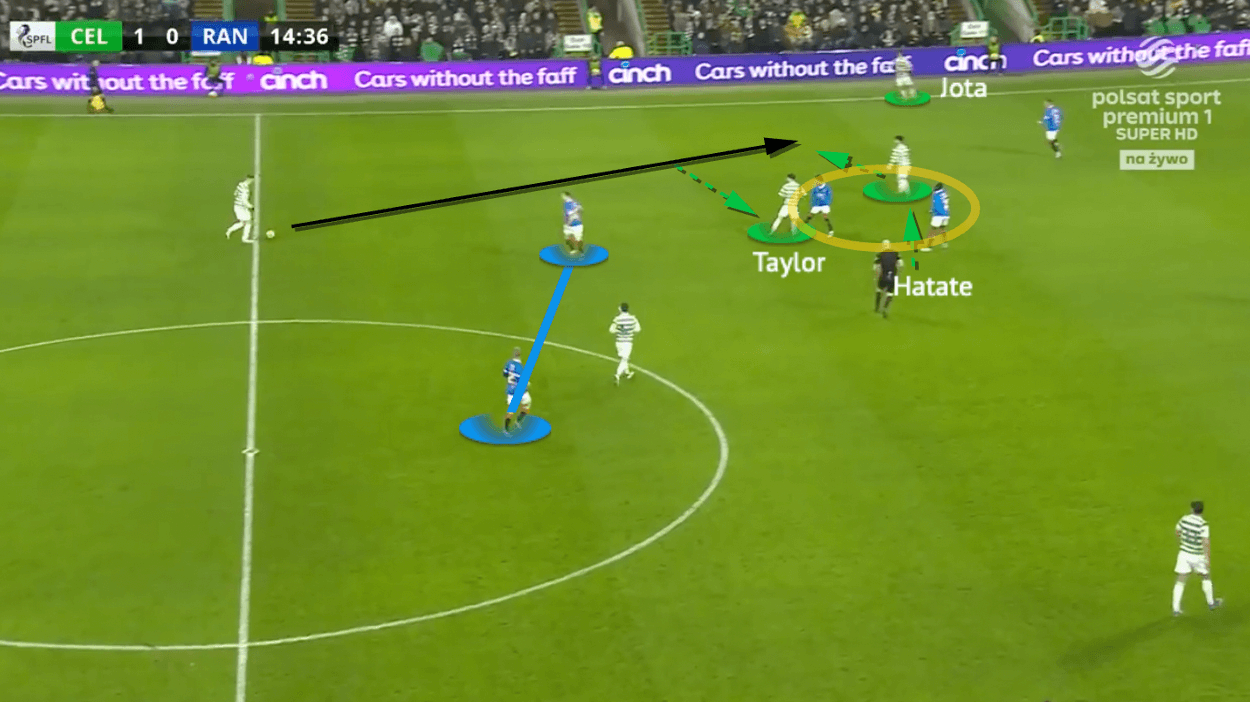
Since the first line of Rangers rarely engaged, Celtic centre-backs comfortably played the ball forward. The passing lanes to the wide players were unmasked very easily with the inside movements of the inverted full-backs. The wingers usually provided the width on the touchlines to manipulate the Rangers full-backs.
On the left side, the positional interchanges mostly involved Hatate, Greg Taylor, and Jota. The loanee from Benfica was often the wide option for Carl Starfelt, while Hatate and Taylor played according to each other. The moves usually began with Taylor going inside into the space between Diallo and the 6 to occupy both, then Hatate dropping out to receive outside of the formation.
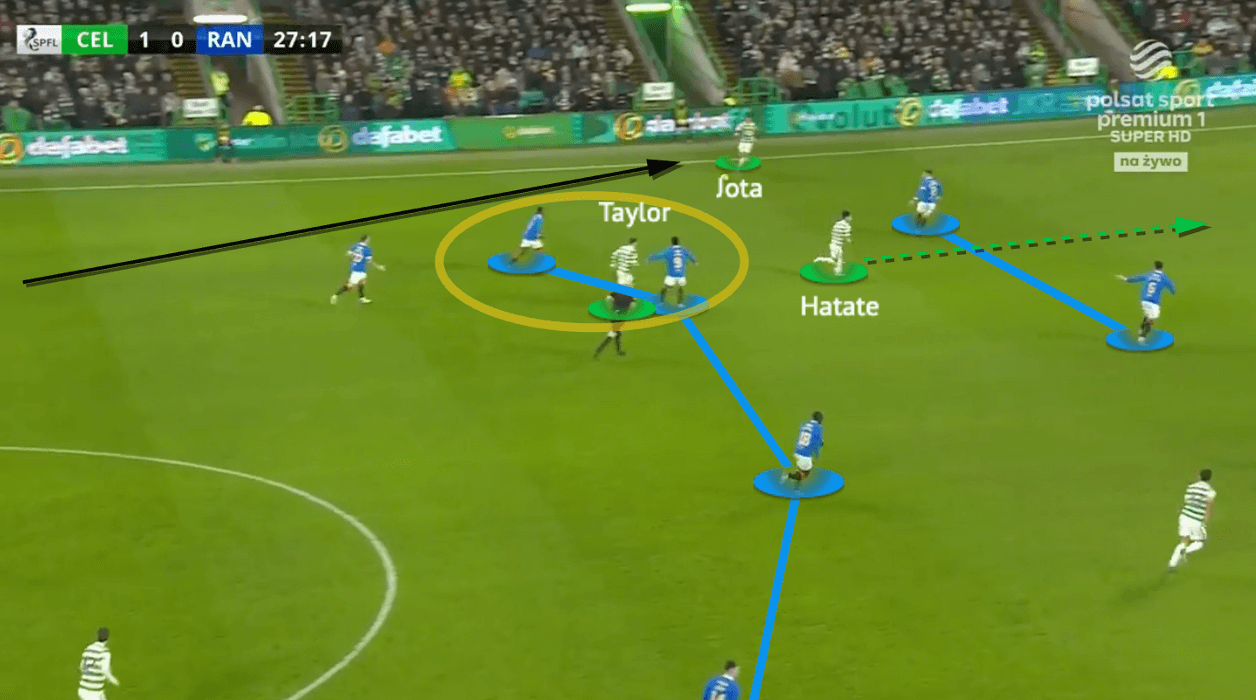
Hatate had a great first half, not only because he scored two goals and gave an assist, but also leading the team’s attack by his dynamic space exploitations on the left side. At times he got rid of Aribo’s radar by moving on his blindside, then, paired up with Jota to overload the right-back in a 2v1.
Nevertheless, the attacks of Celtic were very cautious on this flank as they would not kick the ball forward if the spaces were closed. Postecoglou’s men only break the lines when the conditions/moments were right to avoid unnecessary risks and transitions.
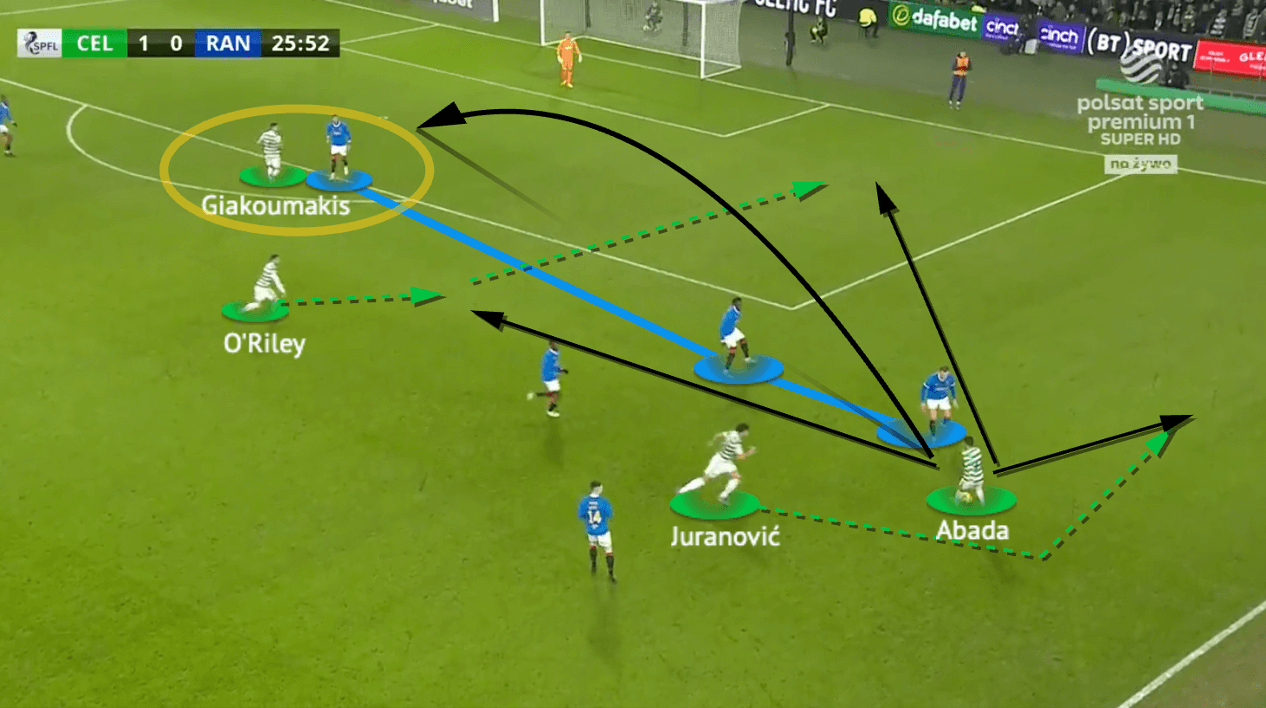
Celtic were rather smooth and direct on the right side, Borna Barišić had a terrible nightmare in the first 45. Since Ryan Kent was usually defending the inside spaces, the right foot of Cameron Carter-Vickers could slice a diagonal pass to the outside cleanly, the ideal case would be bypassing two lines when the wide players received. Another condition to trigger that could be switching the attack from left to right. When Celtic could not progress on the left side, they just move the ball to the right side and the opponents would never be able to chase the ball.
In this game, Abada mostly stayed wide and attacked the Barašić from the flank. The 1v1, pace, dribbling, and skills of the Celtic right-winger was a great threat, the intensity when he drove towards Barašić often fixed the attention of two or three Ranger players, so the others could make deep runs into spaces behind through the channels. It became a decisional dilemma for Bassey on most occasions as his left-back could not deal with Abada. If he went out to cover the wide spaces, he was away from his partner and that would be an issue because Georgios Giakoumakis positioned himself centrally to constantly occupy that space.
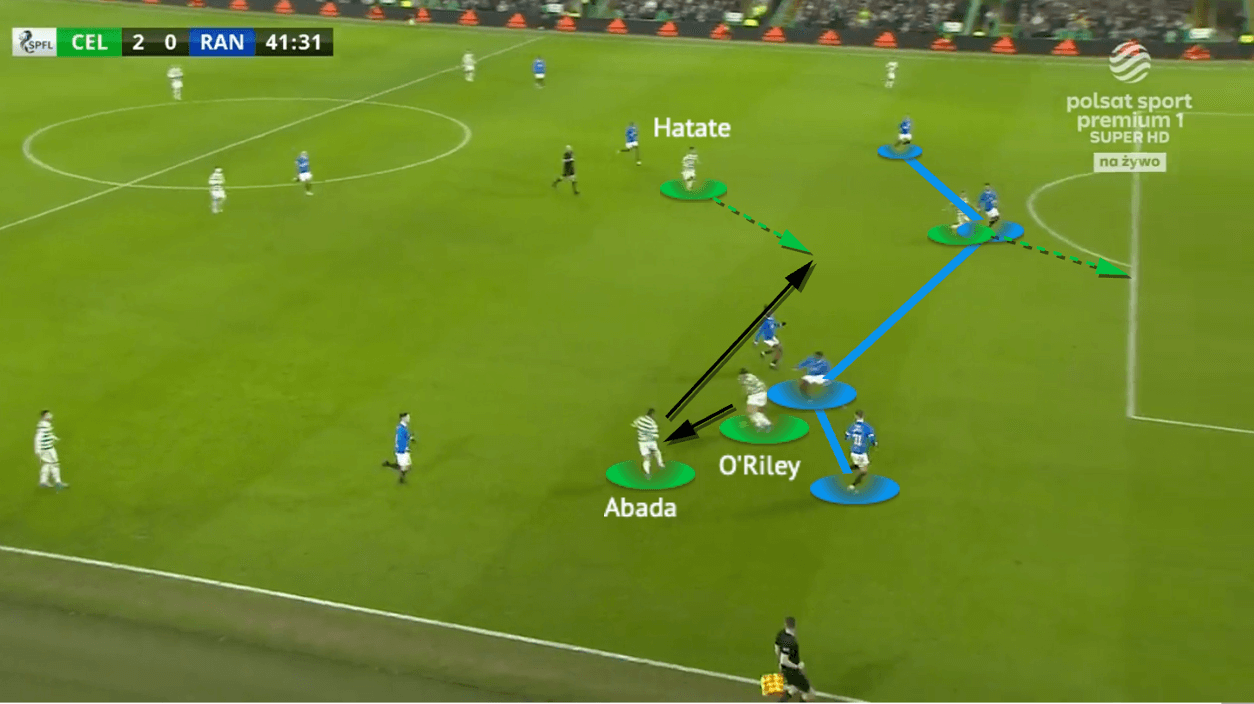
In the first half, these rotations tore the Rangers defence into pieces and Rangers could only chase the shadows, the examples from this analysis were only fragments of these wide Celtic attacks.
High pressing and compactness
The defensive shape of Celtic was very similar to Rangers. Beginning with a 4-3-3 on paper, they also have the right attacking midfielder staying higher, which could end up in a 4-2-3-1 or a 4-4-2 shape. However, the outcomes were very different because Celtic kept a high intensity to press the opponents, and they showed a good spirit and defended as a team in deeper spaces. Especially in the second half, their players were really committed to dropping back to defend the crosses in a low block, Postecoglou’s men had a bigger desire to win the game.
The pressing and defensive structures of Celtic was more compact. When pressing, the winger on the far side would come into balance, while they go man-man and marking the opponents around the ball very tightly to make sure there was no room to escape. Giakoumaktis played an important part in the pressing as he led the team as the first man. When the Rangers centre-backs exchanged a pass, Giakoumaktis would check the availability of teammates behind, if the team was there, he would go on to cut the passing lane between centre-backs and press one of them laterally.
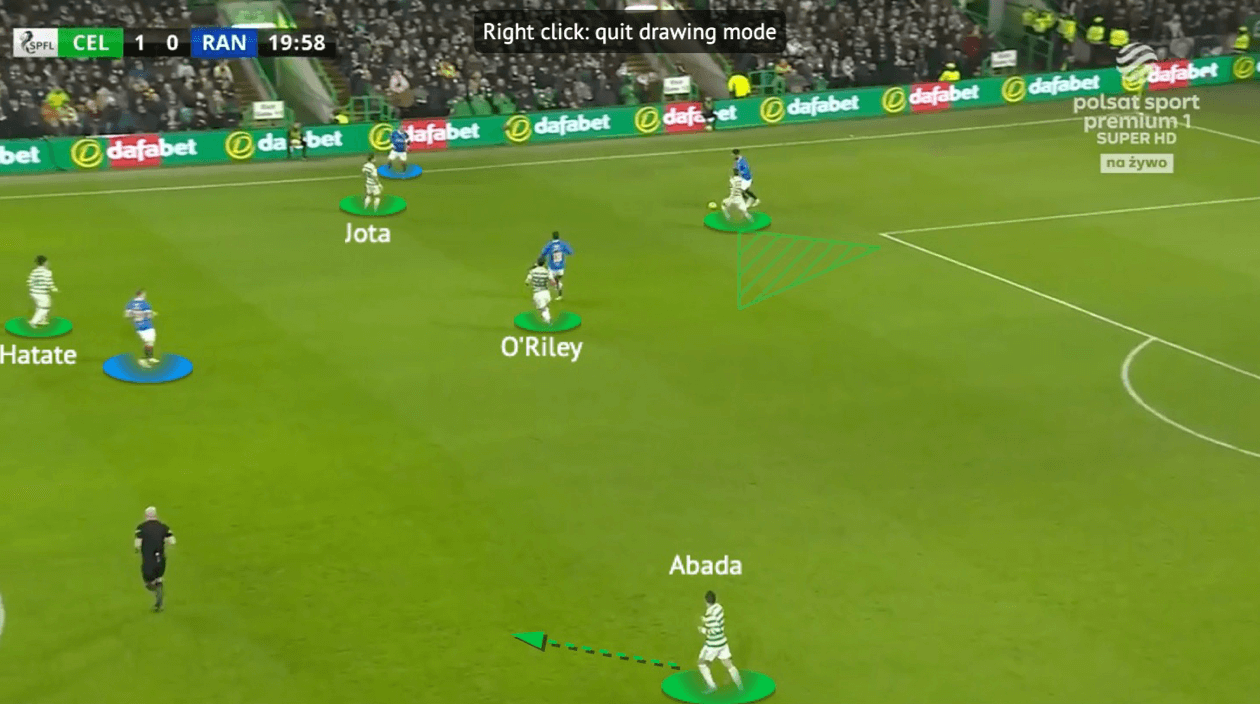
Without possession, Celtic did a great job to limit Kamara’s influence by marking him tightly. That’s why Matt O’Riley always came out high so he could stay closer with the Rangers 6, including the above scenario, he would not hesitate to travel from his half-space across the pitch. Hatate and Callum McGregor would be marking Arfield and Aribo, respectively.
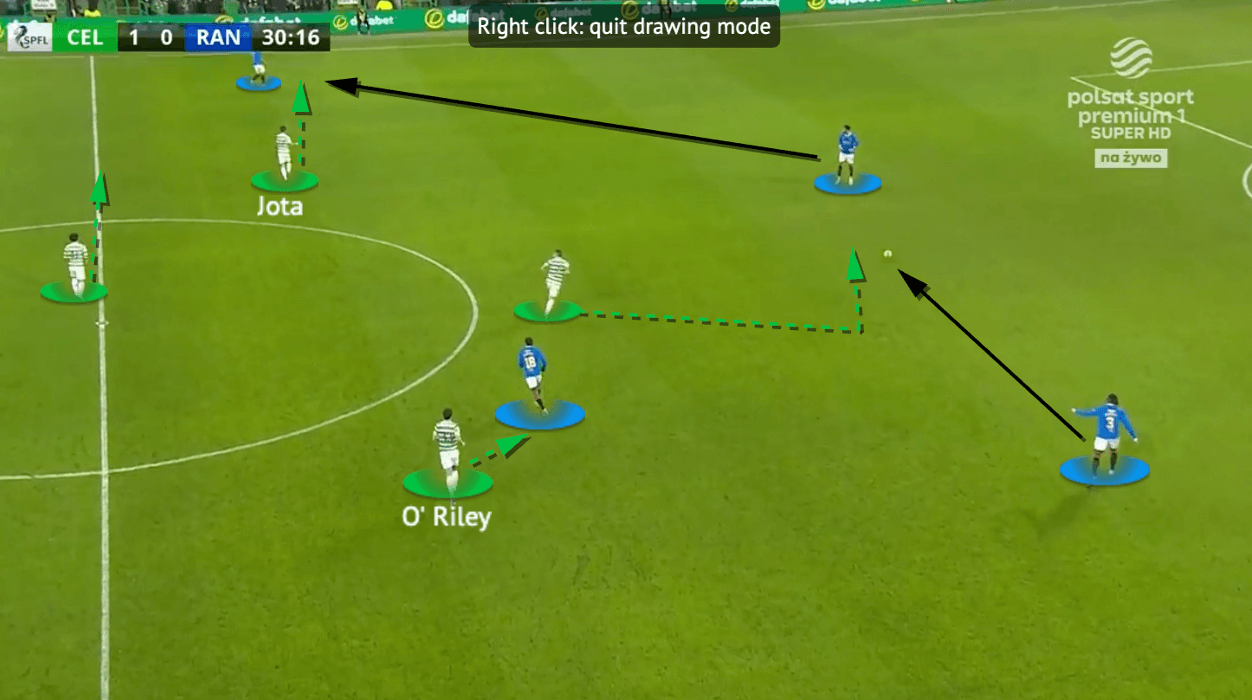
The good protection of Celtic’s central spaces often lured Rangers attacking from the flanks because the wide players looked like being the free options on the flanks. However, those were side traps because Celtic always defended with more numbers out wide, and with a higher intensity to double-press.
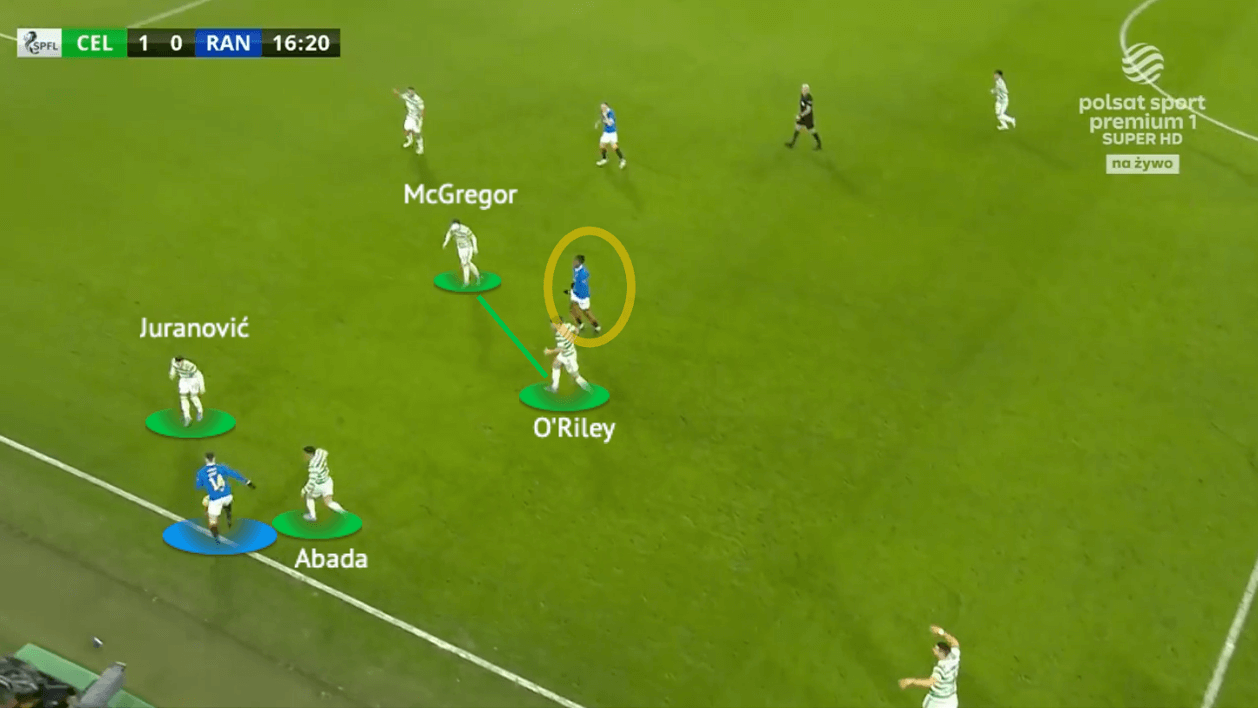
In the wide defending, Celtic always involved three or even four players to make sure that space was conquered. When Rangers arrived in the wide spaces, Celtic players would close them down and make sure there was no way to escape or play behind their centre-backs with multiple angles of pressing. The wingers should be given huge credits for tracking back a lot to help the full-backs, they limited Barašic and James Tavernier’s threat to a large extent.
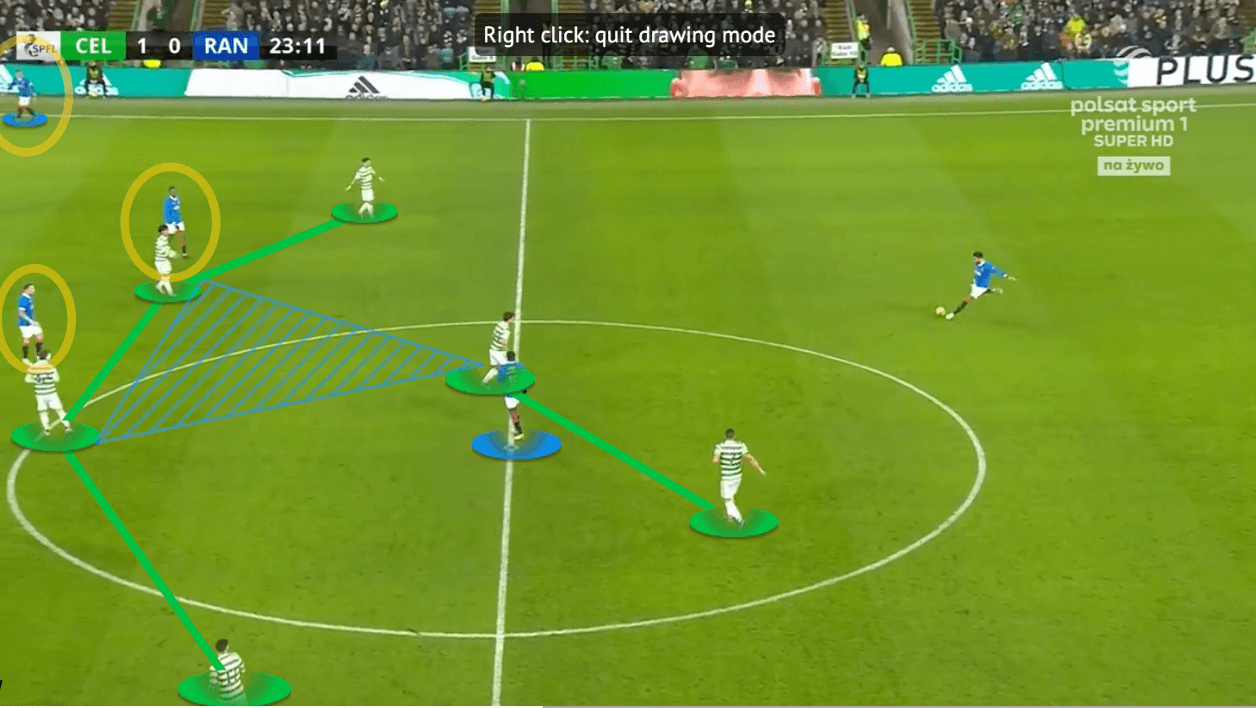
Rangers struggled to enter the final third under good conditions, let alone creating chances to score; their issue in the first half was lacking the presence in the centre, players were afraid of playing or turning in spaces. The attacks were resulted in the flanks unpreparedly with wide players being trapped as shown previously
At the end of the day, generating 0.38 xG from 9 shots was below expectations from Rangers. On average, the xG/shot of van Bronckhorst’s side is 0.04, they could not find the chances in areas closer to the opposition goal.
Second half
The closing stage of the first half was catastrophic to Rangers, so van Bronckhorst made three changes during the break and wanted the players to show the right mentality. Celtic suffered in the second half because they no longer control the ball, Rangers dragged them into a more physical battle with combats in the middle third and in the Celtic penalty zone.
Without possession, Rangers pressed higher, and the shape became a 4-3-1-2 to match the build-up shape. Kent was much closer to press the right-centre-back from the outside to block the diagonal angle from Carter-Vickers to Juranović. Meanwhile, Arfield would be covering the first line and marking C. McGregor, and the right-winger (Fashion Sakala) tucking in as an 8 to maintain the compactness in the centre. These had forced Celtic to play more long balls and in a higher tempo, so the opponents could not dictate comfortably by moving the ball around.
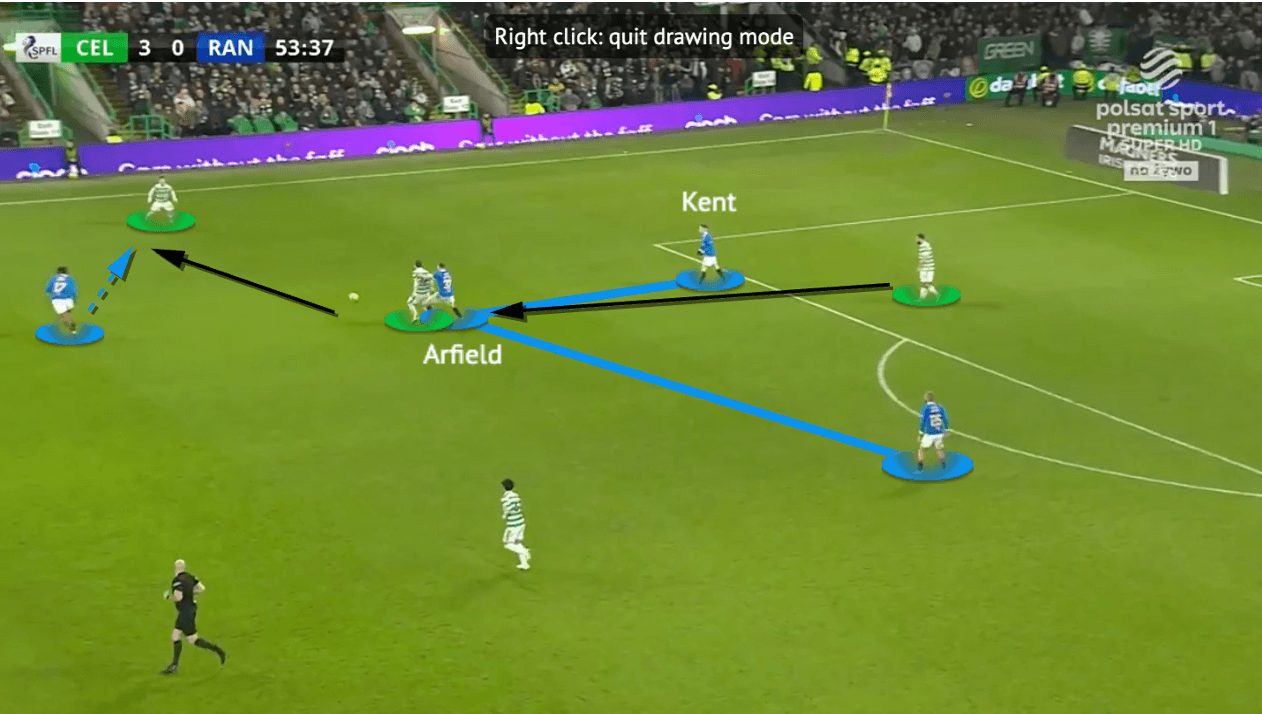
Offensively, Camara did not offer enough support to the backline and he was replaced by Ryan Jack during halftime. The Scottish international was very fresh and helped Rangers move the ball forward at a more efficient rate. Jack was good at operating between the first and second defensive line and offering a vertical option for the centre-back as he moved out of the striker’s shadow. On occasion, Jack also dropped as a wide centre-back to create a numerical 3v2 overload on the Celtic first line, allowing the other centre-backs to carry the ball forward.
With a 6 to operate in spaces, Rangers also established a structure to attack the left side. While they were playing with a pair of deeper full-backs, they tried to create more passing options for Bassey when he received. The guests were better at using the centre-backs to drag the Celtic strikers high, forcing their right-winger to press Bassey. Then, Kent, Aribo, and Jack would move to support Bassey from three angles. Given the press of Abada mostly came from a diagonal angle, Bassey at times connected Kent vertically or passed the ball to that direction to advance the attack.
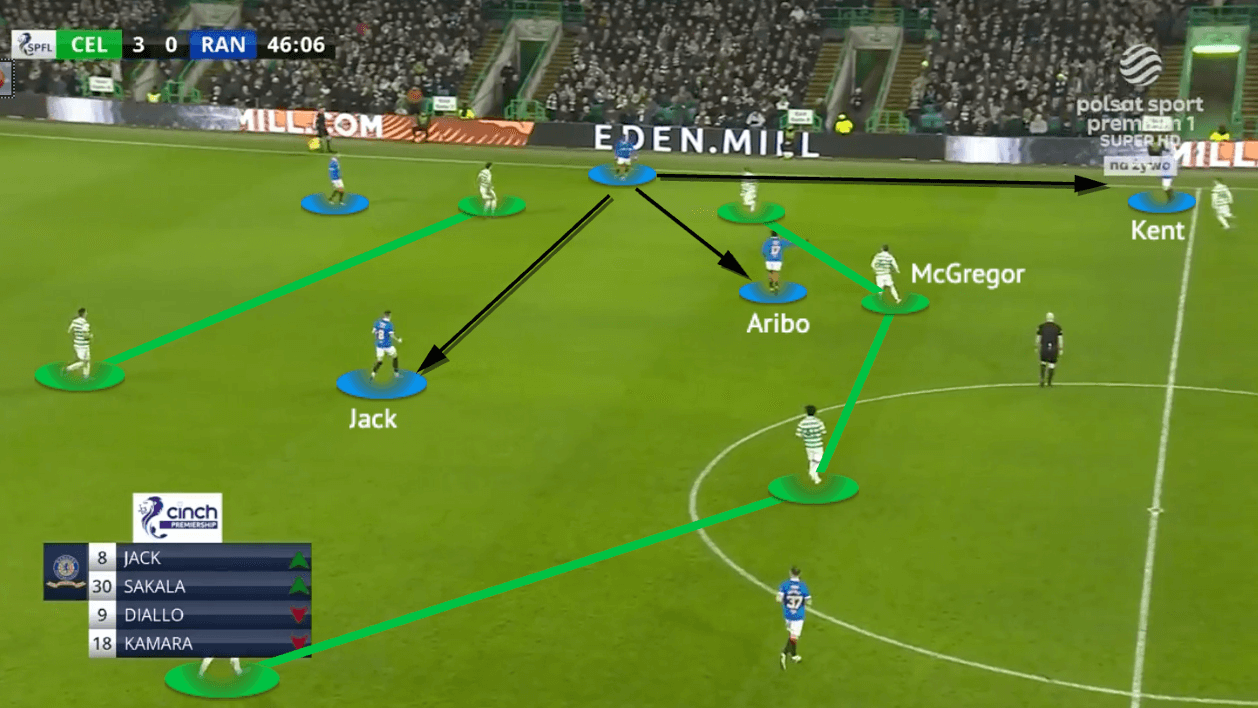
But Rangers did not end up with many threats because the front players were not fit. For example, Kent’s decisions makings and the final deliveries were missing in the offensive third and he did not pose enough threat to Juranović. Hence, they had some chances at the edge of the penalty box attributing to the second balls after the crosses, or Kent cutting inside, but none of them threatened Joe Hart.
Conclusion
The margin of this game was big, but for Rangers, the most disappointing aspect must be the differences shown between the teams. Van Bronckhorst’s side did not show their identity and were rather reactive in this game, so Celtic dominated very easily and that should not be happening in the fourth league clash.
It might be one of the most important games of the season for Celtic, but they could not relax even getting back to the top of the Scottish Premiership because they only had the one-point advantage. Even a lot of positives were shown in this game, there were also many aspects to be improved, Postecoglou would continue transforming Celtic in the remaining of the season, let’s see what happens in May!




Comments